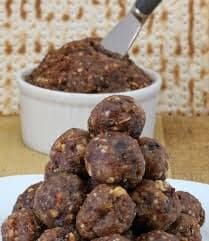תחת התפוח עוררתיך. דרש רב עוירא, בשכר נשים צדקניות שהיו באותו הדור נגאל ישראל ממצרים
Sota 11a
 One of the foods that we serve in the Pesah Seder is the Haroset. A paste typically made with a mixture of fresh fruits, nuts and wine.
One of the foods that we serve in the Pesah Seder is the Haroset. A paste typically made with a mixture of fresh fruits, nuts and wine.
Unlike other foods that are served during the Seder, such as the Maror or the Matsa, the Haroset is not mentioned in the Tora. The Mishna — the work that records the oral tradition of the Jewish people, written around the year 200 of the common era — indicates that the Haroset should be served at the Seder table, but it does not indicate what the function of the Haroset is. This is not uncommon: many times a tradition, or even a Mitsva from the Rabbis (midibre soferim), was widely practiced, while the reason for that Mitsva was unknown, probably forgotten, and the rabbis of the Talmud attempted to rediscover the origen of it.
HAROSET and MAROR
The Rabbis of the Talmud debated about the reason of the Haroset. According to some opinions the Haroset is not a Mitsva per se but an accessory to the bitter herbs or Maror. The Talmud records five different herbs, like lettuce, that could be consumed as Maror to remember the bitter flavor of slavery. Some of these plants contained an acid that could be harmful for digestion (geonim). The Sages explained that the Maror was dipped in the Haroset to neutralize the harmful effects of the acid. According to another opinion, one of the herbs that can be used for Maror (hazeret) contained a worm, that the Haroset was able to eliminate.
A TRIBUTE TO JEWISH MOTHERS
According to Ribbi Eliezer bar Ribbi Tsadoq the Haroset, although eaten with the Maror, is not a mere accessory to the Maror but a mandatory food (mitsva) to have at the Seder. And as such, the Haroset has “a meaning of its own”. The Haroset, usually prepared with apples, reminds us of a very significant event. Pharaoh decreed the death of all newborn Jewish children. But this did not discourage the heroic women of Israel, to remain with their husbands and become pregnant. At the time of delivery, the Jewish mothers would go to the fields and give birth hidden “under the apple trees”. Miraculously, the Midrash explains, God mitigated their pain at the time of giving birth and the Egyptians guards did not discover the babies. According to this opinion, the Haroset should be seen as a tribute to the women of Israel who acted with bravery and heroism. Thanks to their wisdom and sacrifice, the Jewish people grew stronger instead of “disappearing” for lack of procreation, as Pharaoh intended.
HAROSET and BRIKCS
Another opinion, the best known and most accepted, is that the Haroset represents the mud (טיט) that Jewish slaves had to gather with their bare hands every day to produce the bricks, used for the construction projects of Pharaoh. This was a very arduous, humiliating and oppressive job. The images of the mud in our feet and hands, is part of the collective memory of our people as a symbol of slavery and oppression (more about the construction of bricks, BH in the articles to come). Maimonides echoes this last opinion. And thus, in his recipe for Haroset he does not include “apples” as one of the required ingredients. What Maimonides does say is that the Haroset paste should be mixed with tebalin, spices (we will clarify this later), to visually represent the straws that were added into the mud in the process of building the bricks.
JEWISH BLOOD
There is also an opinion in the Talmud of Yerushalayim that says that the Haroset symbolize the blood of Jewish children killed by Pharaoh and his proxies. This idea is mentioned by Rabbi Moshe Isserles (Ram”a, 1530-1572) as the reason for the Ashkenazi custom of adding red wine to the Haroset.
It is possible to connect all these above mentioned reasons (procreation; the making of bricks, and the killing of Jewish children) recalling a tragic Midrash (which in a post-Shoa time, I see no reason not to take this narration in its literal sense) that says that when a Jewish slave did not produce his due quota of bricks, the Egyptians would take one of his children and replaced the missing bricks with his body.
To be continue…
Fuente: halakhaoftheday.org
 eSefarad Noticias del Mundo Sefaradi
eSefarad Noticias del Mundo Sefaradi

